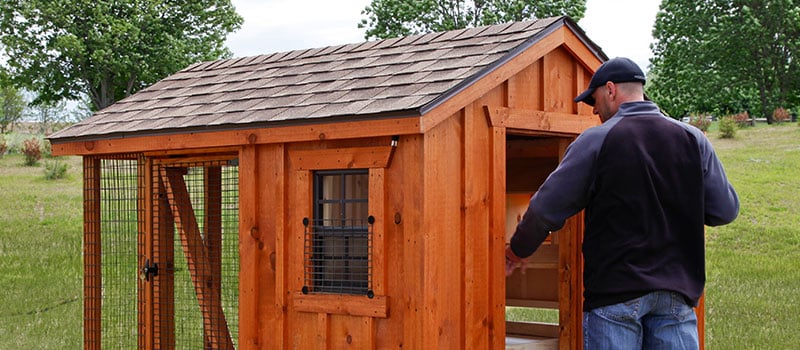Effort & Cost vs. Nutritious Eggs: Are Backyard Chickens Worth It?
by Dakota Storage Buildings, on March 09, 2021
Let's look at the cost and effort of owning backyard chickens versus the healthy eggs you'd get in return.
Like many who value healthy eating, you try to eat farm-to-table as much as possible. Because clean eating is your preference, you look for opportunities to buy fresh, local food that’s free of hormones, chemicals, and harmful pesticides.
Regarding eggs especially, you're already convinced that local eggs from small farms are healthier than those from factory farms. You've seen the studies that prove eggs from free-range chickens are more nutritious than industry-sourced eggs. How about going a step further. To get as close to farm-to-table as possible, instead of buying your eggs from a small, local farm, what if you had your own backyard chickens?
Let's look at the cost and effort of owning backyard chickens versus the health benefits of coop-to-table eggs. If you're concerned about what's all involved, you're not alone. Many have wondered the same thing: How much does it cost to get started? How many chickens should I get? What breed is best? What's the commitment level? Is it worth it?
To answer these questions, you can talk to others who own backyard chickens, research the different breed to find out which breed is right for your space and budget, and discover what it takes to keep chickens happy, healthy — and laying eggs.
Let's dive in.
Check Local Ordinances
Before you run out and buy a clutch of chicks or pullets, make sure you check with your local officials to verify that chickens are allowed where you live. Some municipalities have bans on chickens or limits on how many you can keep on your property. If your town or city isn't yet chicken-friendly, CommunityChickens.com has articles on how to change local ordinances.
Talk to Other Backyard Chicken Owners
As with almost any niche these days, there are support groups and associations for like-minded people, including chicken raisers. In these groups, you can get free advice like what to feed your chickens, which coop bedding is best, the most efficient way to clean a coop, what to do if one of your chickens seems sick, and more. Here are a few places to explore.
YouTube. Simply Google "raising chickens YouTube," you'll and many helpful videos created by serious chicken owners.
Website Forums. Many chicken-related groups form online because people are searching for advice. These communities of like-minded cohorts then grow and offer ongoing support.
Facebook Groups. Backyard chicken keepers have a big community on Facebook. These groups make it easy to communicate and stay united in passion — raising backyard chickens.
Local associations often offer the most personable interactions. Whether it's a chicken-owners organization in your town or county, grassroots groups allow you to feel as though you're part of a family. And often, there's no membership fee. These organizations often have social media groups where you can chat with your fellow members, hold discussions, share photos of your flock and even buy and sell birds. Some offer annual coop tours or open their chicken-raising areas to the public.
Investigate Chicken Breeds
It's no mystery that people like different chicken breeds for a variety of reasons. Depending on your egg color preference, level of expertise or knowledge, and preferred temperament, you may want to do some homework before choosing a backyard chicken breed.
Depending on egg preference, level of expertise, breed temperaments, and the climate of your area, it's best to do some homework before choosing a backyard chicken type. Here are a few of our favorites.

Buckeye. Introduced in the late 19th century at Ohio State and later recognized by the American Poultry Association, the Buckeye, a hardy bird that can withstand cold weather, is the only breed of chicken created by a woman, Nettie Metcalf. Buckeyes are yellow-skinned chickens that lay brown eggs and are the only breed in the American Class to have a pea comb. This bird will tolerate some confinement but does better as a free ranger. This breed has a calm, friendly, and curious personality, although the roosters can be aggressive. The hen lays 150-200 eggs per year and weighs around 6 lbs.

Plymouth Rock. The Plymouth Rock is an American breed of domestic chicken. It was first seen in Massachusetts in the 19th century, and for much of the early 20th century was the most popular chicken breed in the United States. It is a dual-purpose breed, raised both for its meat and for its brown eggs.
The Plymouth Rock chicken is a good breed for first-time chicken owners. They are known for their egg-cellent egg-laying skills and their calm temperament. Additionally, according to thehappychickencoop.com, this breed does well in colder climates.

Wyandotte. The Wyandotte is an American breed of chicken developed in the 1870s. It was named for the indigenous Wyandot people of North America. This type of chicken will lay 150-200 eggs per year and weighs roughly 6 lbs. The male weighs in at around 8 lbs. Both eggs and meat are said to be high quality and tasty. This breed has a docile and calm personality, although hens may occasionally be broody. They are hardy and robust, allowing them to lay eggs throughout the winter.

ISA Brown. The ISA Brown is a crossbreed of chicken with sex-linked coloration. It is thought to have been the result of a complex series of crosses, including but not limited to Rhode Island Reds and Rhode Island Whites, and contains genes from a wide range of breeds.
The breed was developed and patented by a French company in 1978. They are a well-known choice for backyard chicken owners and farmers alike. This gentle chicken breed socializes well with people and is good with kids and other domestic animals. They love to forage, so if they're free-range, ensure your flower beds and vegetable gardens remain pest and weed-free.

Naked Neck. The Naked Neck breed is also called the Transylvanian Naked Neck and Turken. It originated in Transylvania but was primarily developed in Germany. This type of chicken is distinctive, quirky, and downright bizarre-looking. Naked neck chickens are famous for having featherless necks, which makes plucking easier and quicker, as they have less than half the feathers of other comparable fowl. They are brown egg layers and can tolerate cold climates well. Hens weigh around 6 lbs. and roosters weigh roughly 8 lbs. Like most breeds, the males can be very territorial about their hens, but even more so with the Naked Neck, so it's best to have more hens than roosters.
Understand the Necessities
Managing chickens is reasonably straightforward. These are the most basic guidelines for raising healthy and happy hens.
Water. Hens take frequent small sips throughout the day, drinking about one cup of water each day on average. Be aware, though, that chickens tend to drink more during the summer than in the winter. If chickens don't drink enough water, egg production and health can be affected. So make sure they have a monitored supply. You can place water in any container so long as it's easy for the chickens to access, but the easiest way — and least messy — buy a waterer or drinker.
Food. In addition to fresh water, giving your chickens the right amount of appropriate food will contribute to keeping them happy and healthy. Hens need a constant supply of food and quality feed to produce the best quality eggs. Look for a protein-rich chicken feed with adequate shell grit. Remember that egg-laying chickens need 16-20% protein and a complex combination of vitamins, minerals, and calcium. To learn more about chicken nutrition, read Nutrition for the Backyard Flock. Keep in mind that feeding them the wrong food can lead to poor egg quality, weight loss, and illness.
Routine. Both you and your chickens will thrive if a routine is in place. In the morning, let your chickens out of the coop, replenish their feed and water, collect any laid eggs, and look around to make sure everything is in working order. When the sun begins to set, it's time to start the evening routine. This will include locking your hens safely inside the coop and collecting any new eggs. On the weekend, clean the coop and tend to the nesting boxes. You'll need to wash the floor, remove caked-on excrement, and replace nesting box bedding.
Housing. Each chicken needs three to four square feet of space in the coop and another three to four square feet in the run. Because chickens are social animals, a minimum of six chickens is recommended, requiring an 18-sq. foot coop and a run of equal size. If you're a do-it-yourselfer, the internet is rife with ideas and instructions, or you can buy a ready-built chicken coop like this one. Experts also recommend having one nesting box inside the coop for every three to four chickens.
Next Step
While you might not be ready to start your backyard chicken journey today, we hope you've gained some clarity and assurance that raising backyard chickens isn't overwhelming and that the results are worth it. Having more than enough highly nutritious eggs available to you daily (not to mention the most delicious quiche, omelets, and frittata ever) seems like a great trade-off for the time, effort, and money put into raising backyard chickens.
However, before you check your local ordinances, consider chicken breed options, or map out a backyard coop plan, download our free resource, The Beginner's Guide to Getting Backyard Chickens. It has even more helpful information about chicken ownership.
Read more articles on backyard chickens.
About Dakota Storage Buildings
Life is demanding and full of choices. We’d love to make just one aspect of your life a little easier. That’s why it’s our mission to provide storage solutions you can trust, from sheds and garages to coops and kennels. Customize your storage building with our online 3-D configurator, explore our stock buildings, or find a display location near you. Our team is now serving North Dakota, South Dakota, Minnesota, western Wisconsin, northeast Nebraska, and north-central Iowa. Discover The Dakota Difference.




























